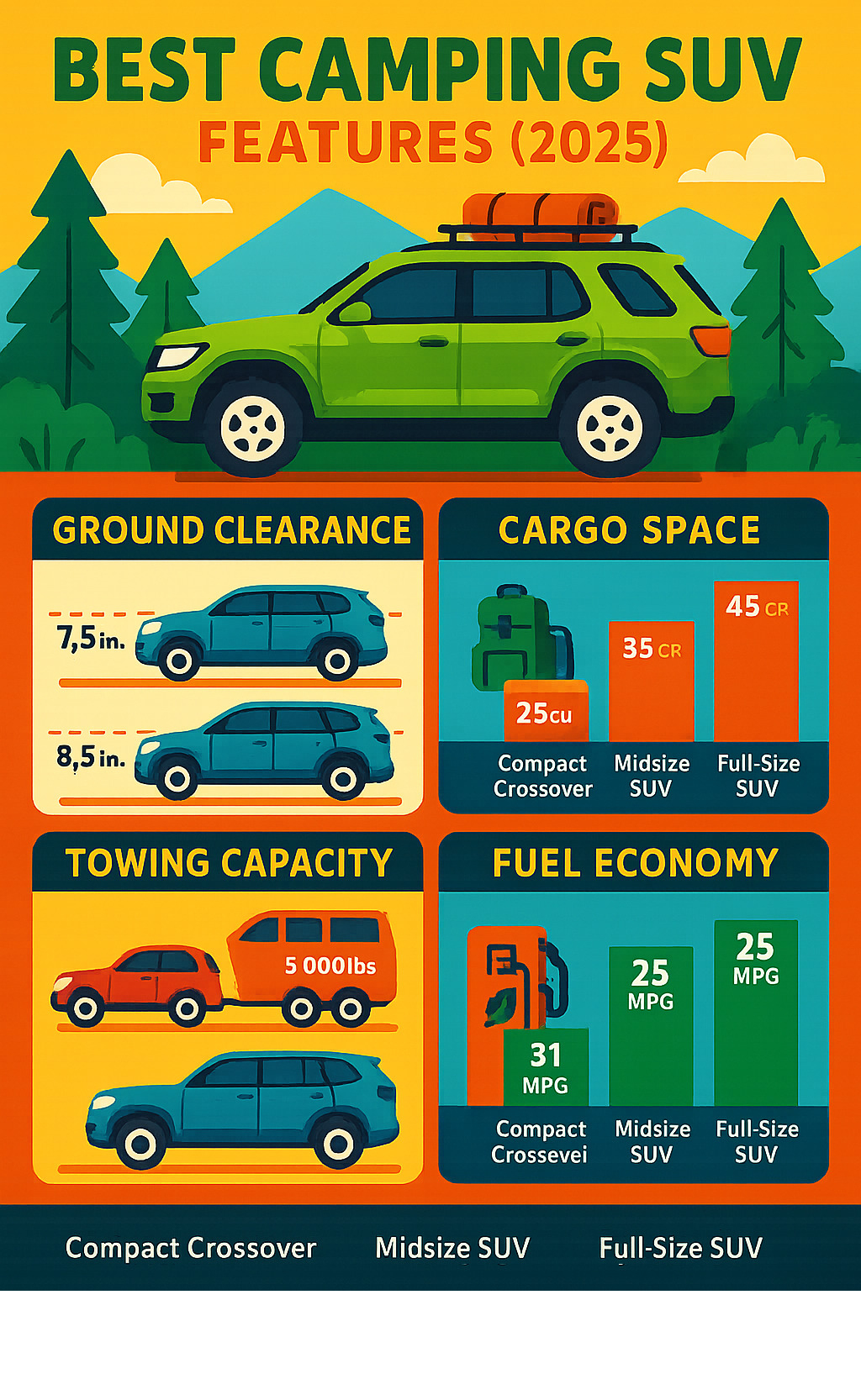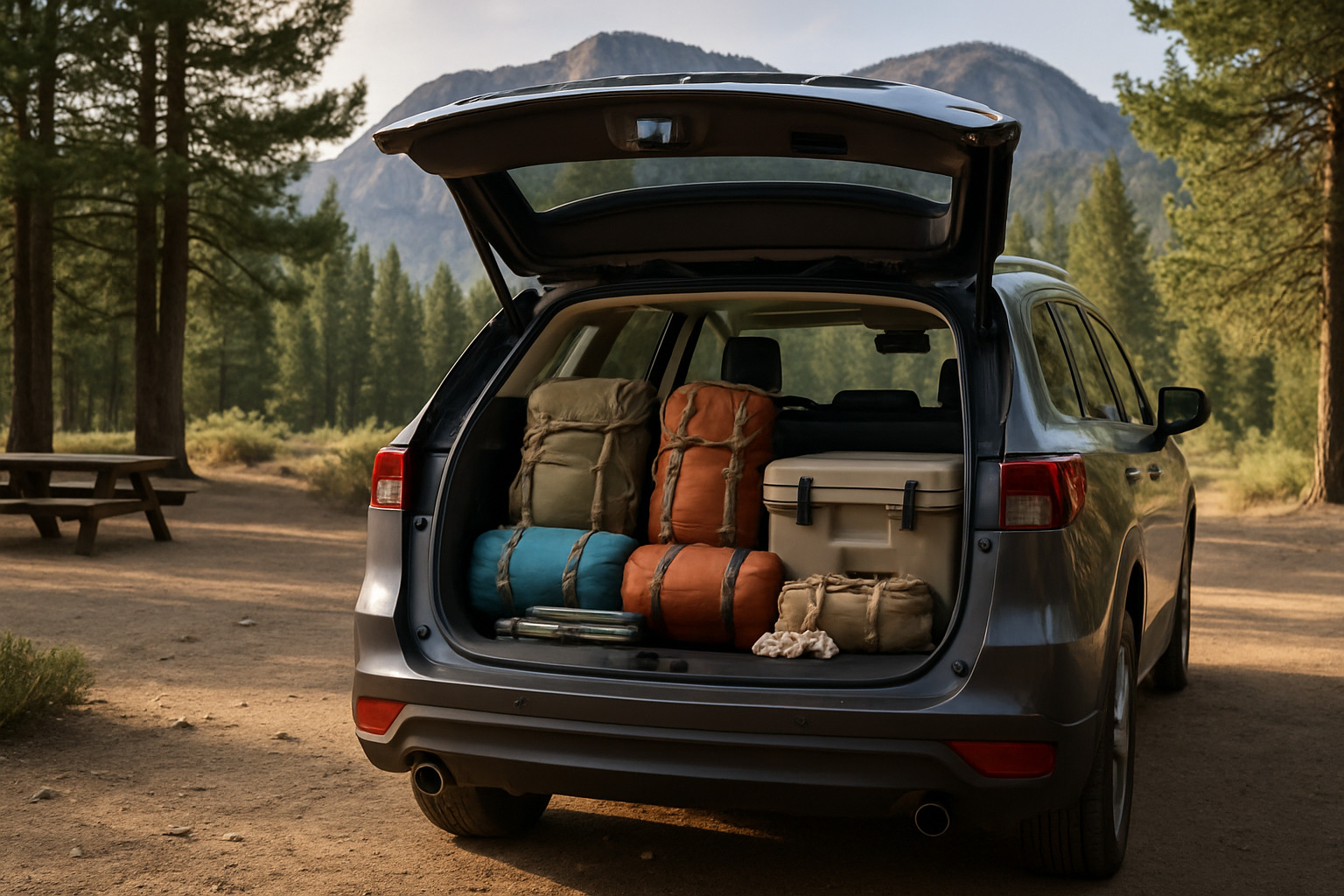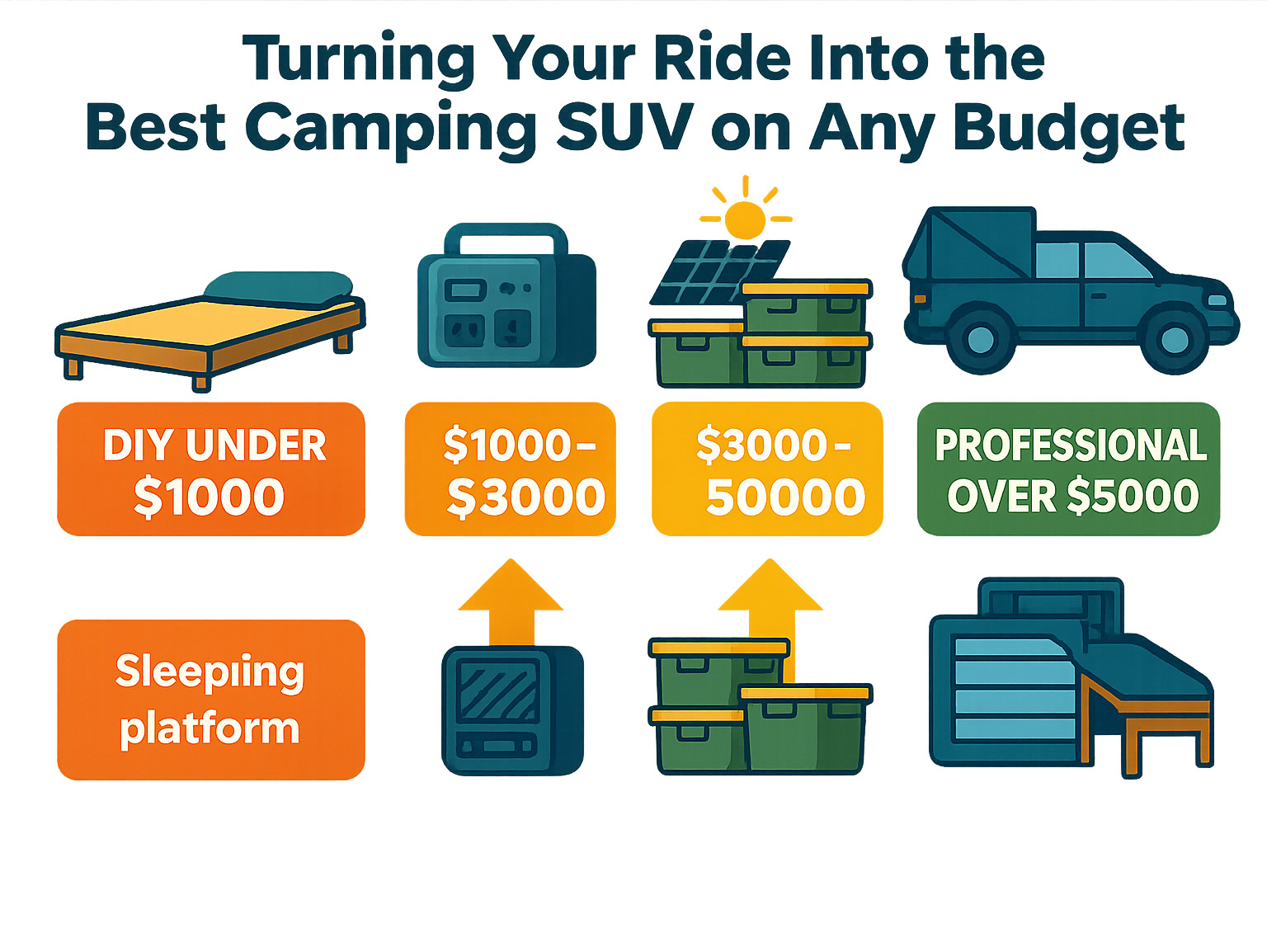Best Camping SUV 2025: 10 Top Picks for Epic Adventures
Why the Right SUV Makes All the Difference for Your Outdoor Trips
Finding the best camping SUV means balancing off-road capability, interior space, and daily drivability – and the right choice can transform your weekend getaways from stressful gear-shuffling marathons into seamless outdoor escapes.
Top Camping SUVs for 2025:
- Full-Size Champions: Chevrolet Tahoe, Ford Expedition, Toyota Sequoia
- Midsize Trail Masters: Toyota 4Runner, Jeep Wrangler, Subaru Outback Wilderness
- Compact Budget Winners: Subaru Forester, Honda CR-V, Mazda CX-50
- Eco-Friendly Options: Toyota Highlander Hybrid, Rivian R1T, Kia EV9
As one outdoor enthusiast put it: “With basic gear like a sleeping bag or an air mattress you can [sleep in an SUV], and additional equipment improves comfort.” Modern SUVs have evolved far beyond simple transportation – they’re mobile basecamps that can haul your gear, sleep your family, and get you to places where sedans fear to tread.
Most modern SUVs let you fold the rear seats flat to create a level sleeping surface, while features like all-wheel drive, generous ground clearance, and impressive towing capacity make them ideal for reaching remote campsites.
Whether you’re planning solo weekend escapes or family trips to national parks, the right SUV becomes your gateway to outdoor freedom – no tent setup required.

What Makes an SUV Ideal for Camping?
Picture this: you’re driving down a winding mountain road, your best camping SUV loaded with gear, ready for a weekend under the stars. What separates a truly capable camping SUV from just another vehicle? It all comes down to a few key features that can make or break your outdoor trip.
Ground clearance is your first line of defense against trail obstacles. Most camping enthusiasts need at least 8.5 inches to handle basic forest service roads and mild trails without scraping the undercarriage. If you’re planning to tackle more challenging terrain, you’ll want 10.5 inches or more.
All-wheel drive (AWD) or four-wheel drive (4WD) isn’t just a nice-to-have feature – it’s essential when you’re dealing with loose gravel, sand, mud, or unexpected weather. AWD typically kicks in automatically when it senses slipping, making it perfect for most camping situations. 4WD often requires manual engagement and may include low-range gearing for maximum traction.
The magic happens when you find fold-flat rear seats. This feature transforms your SUV from a people-hauler into a mobile bedroom in minutes. Take the 2025 Subaru Outback – with its rear seats folded, you get over 75 cubic feet of cargo space. That’s enough room for two adults to sleep comfortably, plus all your gear.
Towing capacity becomes crucial if you’re hauling a trailer, boat, or ATV to your campsite. The Toyota 4Runner can handle up to 5,000 pounds, while properly equipped full-size models can tow over 10,000 pounds. Don’t forget about payload – that’s the weight of passengers plus all your camping gear combined.
Modern interior technology can seriously upgrade your camping experience. Household-style power outlets let you charge devices or run small appliances. Built-in navigation keeps you on track when cell service disappears. Climate control that runs while parked? That’s a game-changer for hot summer nights.
Reliability might seem obvious, but it’s worth emphasizing. Breaking down miles from civilization isn’t just inconvenient – it can be dangerous. Look for SUVs with solid track records and good dealer networks for peace of mind.
More info about Camping in an SUV
Off-Road Capability vs. On-Road Comfort
Here’s the eternal camping SUV dilemma: do you build a rock-crawling monster or a highway cruiser? The best camping SUV finds that sweet spot between trail capability and daily drivability.
Suspension travel determines how well your SUV absorbs the punishment from rocks, ruts, and washboard roads. Models like the Ford Bronco Sasquatch and Toyota 4Runner TRD Pro feature long-travel shocks designed for serious off-road trips. The trade-off? They can feel bouncy on smooth pavement.
Approach, departure, and breakover angles matter when you’re navigating steep terrain or large obstacles. The Land Rover Defender offers nearly 12 inches of ground clearance with optional air suspension, letting it tackle challenging approaches while remaining civilized for daily commuting.
Tire options significantly impact both capability and comfort. All-terrain tires provide a good compromise – decent off-road traction without excessive highway noise. Dedicated mud-terrain tires excel in extreme conditions but can sound like a freight train on the interstate.
Sleeping Inside Your SUV
Converting your SUV into a comfortable bedroom requires some planning, but the payoff is huge – no tent setup, better security, and protection from weather and wildlife.
Most modern SUVs allow rear seats to fold flat, but you’ll often find uneven surfaces and intrusions from wheel wells. A sleeping platform solves these problems by creating a level surface while providing valuable storage space underneath for gear.
Custom-built platforms using plywood or aluminum offer the most flexibility for your specific needs. Modular systems like conversion kits provide easier installation and removal if you need to switch between camping and daily use.
Mattress selection impacts both comfort and practicality. Memory foam mattresses provide excellent comfort but take up significant space when stored. Air mattresses pack smaller but require inflation each night. The Therm-a-Rest NeoAir XTherm offers an R-value of 6.9 for insulation and packs to just 2.5 inches thick.
Ventilation and privacy become critical for comfortable sleeping. Window screens allow fresh air while keeping bugs out. Privacy screens or tinted windows provide security and block unwanted light. Many campers use Velcro-attached panels or magnetic screens for easy installation and removal.
Best Camping SUV Roundup 2025
Our best camping SUV selections span multiple categories to match different needs and budgets. We’ve evaluated each model based on ground clearance, cargo space, towing capacity, fuel economy, and overall camping suitability.
The camping SUV landscape has never been more diverse, with options ranging from budget-friendly compact crossovers under $30,000 to luxury models exceeding $70,000. Ground clearance ranges from 6.7 inches in budget models to nearly 12 inches in premium SUVs with air suspension.
Full-Size Family Haulers: Space & Towing Kings
When your camping trips involve large families, extensive gear, or heavy trailers, full-size SUVs deliver best capability. The 2025 Chevrolet Tahoe leads our full-size category with up to 420 horsepower and a base MSRP starting around $59,000. Its combination of power, space, and towing capacity makes it ideal for families who refuse to compromise.
The Ford Expedition offers three-row seating and substantial cargo capacity, with ground clearance of 7.9 inches handling most camping scenarios. The available Z71 off-road package adds improved capability for serious trail work.
Toyota’s Sequoia brings legendary reliability to the full-size segment. While it may not match domestic competitors in raw cargo volume, its reputation for durability makes it a favorite among overlanders planning extended remote trips.
Midsize Trip Specialists: Trail-Ready Yet Daily-Drivable
The midsize segment offers the sweet spot for many camping enthusiasts – enough capability for serious trail work while remaining manageable for daily driving. The 2024 Toyota 4Runner truly shines when it’s covered in mud, featuring a 270-horsepower V6 engine and up to 5,000 pounds of towing capacity.
You’ll see a Jeep Wrangler at nearly every campsite because it offers exceptional off-road capability. The 2024 Wrangler provides 285 horsepower, 9.7 inches of ground clearance, and 35.6 cubic feet of cargo space. The Rubicon 4xe hybrid variant adds plug-in capability and bidirectional charging to power camping accessories.
The 2024 Ford Bronco represents a modern take on the classic off-road SUV. With 275 horsepower from its turbo-four engine and 8 inches of ground clearance, it handles serious terrain while offering modern amenities.
The Subaru Outback Wilderness deserves special mention for adding significant ground clearance (9.5 inches) without compromising cargo space (75.7 cubic feet with seats folded). Its standard all-wheel drive and rugged build quality make it perfect for accessing remote campsites while delivering over 30 mpg on the highway.
Compact & Budget Picks: Solo-Camper Favorites
Budget-conscious campers and solo travelers will find excellent options in the compact SUV segment. The 2025 Subaru Forester features standard all-wheel drive and a base MSRP of $29,695, providing affordable access to off-road capability. Its boxy shape maximizes interior space, making it surprisingly accommodating for car camping.
The Honda CR-V’s compact size makes it ideal for quick weekend getaways, despite having smaller cargo space than larger alternatives. Its reliability and fuel efficiency make it a practical choice for frequent camping trips.
The Mazda CX-50 offers a compelling blend of style and capability with its 187-horsepower engine. At an MSRP of $30,300, it provides excellent value for campers who want modern features without breaking the budget.
Surprisingly, the Kia Soul earns a spot in our compact category despite its car-like stance. With 6.7 inches of ground clearance and 62.1 cubic feet of cargo space with seats folded, it proves that you don’t need traditional SUV styling to create a capable camping vehicle. Its $19,890 starting price makes it the most affordable option on our list.
Green Machines: Hybrid & Electric Leaders
Environmental consciousness doesn’t mean sacrificing camping capability. The 2024 Toyota Highlander Hybrid delivers 36 mpg on the highway while providing 48.4 cubic feet of cargo space with the third row folded. Its 243-horsepower hybrid system offers plenty of power for loaded camping trips while minimizing fuel stops.
The 2025 Rivian R1T represents the cutting edge of electric camping vehicles. With 533 horsepower in standard form, it can wade through up to three feet of water and includes an optional camp kitchen powered by the truck’s battery. Just remember to monitor your power consumption to avoid being stranded.
The Kia EV9 brings three-row electric capability to the camping world. While still relatively new, early reports suggest it offers the space and technology features that make modern camping more comfortable, though charging infrastructure remains a consideration for remote camping.
Scientific research on portable power
Why a Best Camping SUV Beats a Truck for Weekend Getaways
While pickup trucks dominate overlanding discussions, SUVs offer distinct advantages for weekend camping. Interior sleeping capability tops the list – you can quickly convert your SUV into a weatherproof bedroom without setting up external tents or dealing with truck bed camping systems.
Versatility makes SUVs ideal for families who need passenger space during the week and cargo capacity on weekends. Most SUVs offer multiple seating configurations, allowing you to optimize for either people or gear as needed.
Easier parking becomes apparent in crowded campgrounds, urban areas, and tight forest roads. Weather protection gives SUVs another edge – your gear stays dry and secure inside the vehicle.
How to Choose & Outfit the Best Camping SUV
Choosing your perfect camping SUV starts with an honest conversation about what you actually need. Are you planning weekend trips to established campgrounds, or do you dream of reaching remote dispersed sites? Your camping style determines everything else.
Budget planning goes far beyond the sticker price. That shiny new SUV looks tempting, but remember to factor in fuel costs, insurance premiums, regular maintenance, and all those camping accessories you’ll inevitably want. Sometimes a well-maintained used Toyota 4Runner or Subaru Outback serves you better than a new model that drains your accessory budget.
The new versus used debate has no wrong answer – just different trade-offs. New SUVs bring the latest safety features, full warranties, and modern tech. But used models offer better value and less heartbreak when you inevitably scrape against that low-hanging branch.
Think about whether your best camping SUV will pull double duty as your daily driver. If you’re commuting Monday through Friday, you’ll want something that balances trail capability with highway comfort. Solo campers and couples can make compact SUVs work beautifully, while families with kids need the space of midsize or full-size models.
More info about Best Overland Vehicles

Must-Have Camping Accessories
Rooftop tents have revolutionized SUV camping by turning your roof into a comfortable bedroom while keeping your cargo area free for gear. Hard-shell models pop open in minutes and provide excellent weather protection, though they’re pricier and heavier. Soft-shell versions pack smaller and cost less but take longer to set up.
Awnings create instant outdoor living space that transforms your camping experience. A simple pull-out awning provides shade and light rain protection, while more elaborate systems can create up to 11 square meters of covered area.
Portable power stations have become the backbone of modern camping. These battery packs keep your phones charged, run LED lights, and power small appliances without running your SUV’s engine. Add solar panels for longer trips.
Portable refrigerators eliminate the ice-buying dance and keep food safely chilled. Basic 12-volt models run directly from your SUV’s electrical system, while advanced units include battery packs for operation when parked.
Recovery equipment becomes critical once you venture beyond paved roads. Start with basics like a tow strap, shackles, and a shovel. More serious off-roaders should add winches, traction boards, and tire repair kits.
Common Mistakes to Avoid
Overloading kills more camping trips than bad weather. Every SUV has payload limits printed on the driver’s doorjamb – ignore them at your peril. Payload includes passengers, gear, roof loads, and trailer tongue weight.
Ignoring the difference between static and dynamic weight limits causes expensive mistakes. Your SUV might support 150 pounds on the roof when parked but only 75 pounds while driving.
Skipping pre-trip maintenance becomes costly when problems arise in remote locations. Check fluids, tire pressure, and belts before departure. Carry basic tools and spare parts appropriate for your vehicle and planned route.
Forgetting about permits and regulations leads to unwanted surprises. Many camping areas require permits, have vehicle restrictions, or prohibit overnight parking. Research local regulations before departure.
Turning Your Ride Into the Best Camping SUV on Any Budget
DIY modifications can transform any SUV into a capable camping rig without requiring a second mortgage. Start with basics like window coverings for privacy, a sleeping platform for comfort, and organizational systems for gear management.
A basic plywood sleeping platform costs under $100 in materials and creates valuable storage space underneath. Add a memory foam mattress topper, and you’ve created a comfortable sleeping arrangement that rivals expensive conversion kits.
Conversion kits offer more sophisticated solutions for those wanting professional results without custom fabrication. Complete systems start around $700 for basic setups, while premium aluminum platforms can exceed $1,200.
Power systems range from simple solutions to complex installations. A basic setup using a portable power station provides lights and device charging for under $300. Full electrical systems with house batteries and solar charging can cost several thousand dollars but offer true off-grid capability.
Budget planning for a basic camping conversion typically includes a sleeping platform ($100-800), mattress ($100-300), window coverings ($50-200), organizational systems ($100-500), and basic power setup ($200-1000). You can create a functional camping SUV for under $1,000 with DIY approaches, while professional installations can exceed $5,000.

Frequently Asked Questions About the Best Camping SUV
How much ground clearance do I really need off-pavement?
The honest answer? It depends on where you’re planning to take your trips. For weekend warriors hitting basic forest service roads and maintained campgrounds, 7-8 inches of ground clearance will handle most situations without breaking a sweat.
But if you’re eyeing those dispersed camping spots that require navigating mild trails and rocky access roads, you’ll want to bump that up to at least 8.5 inches. This sweet spot gives you the confidence to tackle most camping scenarios without constantly worrying about scraping your undercarriage.
If you’re the type who gets excited about rock crawling and technical terrain, 10.5 inches or more becomes your target. Models like the Subaru Outback Wilderness with its 9.5 inches and the Toyota 4Runner TRD Pro with 9+ inches hit that perfect balance for serious camping trips.
Ground clearance is just one piece of the puzzle. Approach, departure, and breakover angles matter just as much when you’re navigating steep terrain or large obstacles.
Can two adults sleep comfortably in a compact crossover?
Absolutely! While it might sound cramped, most modern compact SUVs can comfortably accommodate two adults for sleeping – though comfort levels definitely vary by model and how particular you are about your sleeping arrangements.
The secret lies in proper setup and having realistic expectations. Models like the Subaru Forester and Honda CR-V offer sufficient length and width for two adults when those rear seats fold flat. The key is creating a level sleeping surface and maximizing the available space.
Adding a quality sleeping platform transforms the experience completely. It eliminates those annoying uneven surfaces and humps while creating valuable storage space underneath for all your gear.
Air mattresses designed specifically for vehicle camping help maximize comfort in tight spaces. Look for models that are actually sized for SUV cargo areas, and consider self-inflating options to simplify your setup process.
Solo campers will find compact SUVs quite comfortable, with plenty of room for gear storage and much easier setup. Couples should definitely test their chosen vehicle before committing to ensure there’s adequate space for both occupants.
Are hybrid or electric SUVs practical for remote campsites?
Hybrid SUVs are fantastic for camping! They offer improved fuel economy without sacrificing the capability you need for outdoor trips. The Toyota Highlander Hybrid delivers 36 mpg highway while still providing substantial cargo space and towing capacity.
Electric SUVs present a more complex situation for remote camping. Range limitations become a real concern when you’re accessing distant campsites, and charging infrastructure remains pretty sparse in many outdoor recreation areas. You’ll need to plan your trips more carefully.
However, electric vehicles offer some unique advantages for established campground camping. Silent operation means you can leave early without waking up the entire campground, and some models provide household power outlets for your camping equipment.
The Rivian R1T represents the current pinnacle of electric camping capability, with its innovative camp kitchen option and substantial range. However, careful trip planning remains essential to ensure you have adequate charging opportunities throughout your journey.
The bottom line? Hybrids work great for most camping scenarios, while electric vehicles excel for established campgrounds but require more planning for remote trips.
Conclusion
Finding your best camping SUV comes down to matching your outdoor dreams with real-world needs. After testing dozens of models and talking with countless camping enthusiasts, we’ve learned that the perfect SUV isn’t about having every feature – it’s about having the right features for how you actually camp.
Full-size powerhouses like the Chevrolet Tahoe and Ford Expedition shine when you’re hauling the whole family plus enough gear for a week-long trip. Midsize trail specialists hit the sweet spot for most campers. The Toyota 4Runner’s legendary reliability means you’ll make it home from that remote fishing spot, while the Subaru Outback Wilderness proves you don’t need to sacrifice fuel economy for capability.
Budget-friendly compact SUVs like the Subaru Forester and Honda CR-V prove that camping doesn’t require a massive investment. Solo campers and couples often find these smaller rigs easier to maneuver on narrow forest roads, and they’re much friendlier to your wallet at the gas pump.
Hybrid and electric options are rapidly improving, with models like the Toyota Highlander Hybrid delivering impressive fuel economy without giving up camping essentials. The Rivian R1T represents the cutting edge, though charging infrastructure still limits where you can roam.
Your decision checklist should prioritize ground clearance of 8.5 inches or more for accessing those hidden campsites, adequate cargo space for your typical gear load, and proven reliability for peace of mind in remote areas. Don’t forget about towing capacity if you’re planning to haul trailers, and consider fuel economy for those long drives to distant destinations.
Here’s the truth we’ve learned from years of camping trips: the best camping SUV is simply the one that gets you outdoors regularly. We’ve seen amazing trips happen in basic vehicles with creative setups, and expensive rigs that rarely leave the driveway. Start with what you can afford, add accessories gradually, and focus on building memories rather than perfect gear.
At Car News 4 You, we’re passionate about how automotive innovation opens up new outdoor possibilities. Whether you’re drawn to the latest hybrid technology or prefer the proven capability of traditional SUVs, we’re here to help you find the vehicle that becomes your gateway to outdoor freedom.








